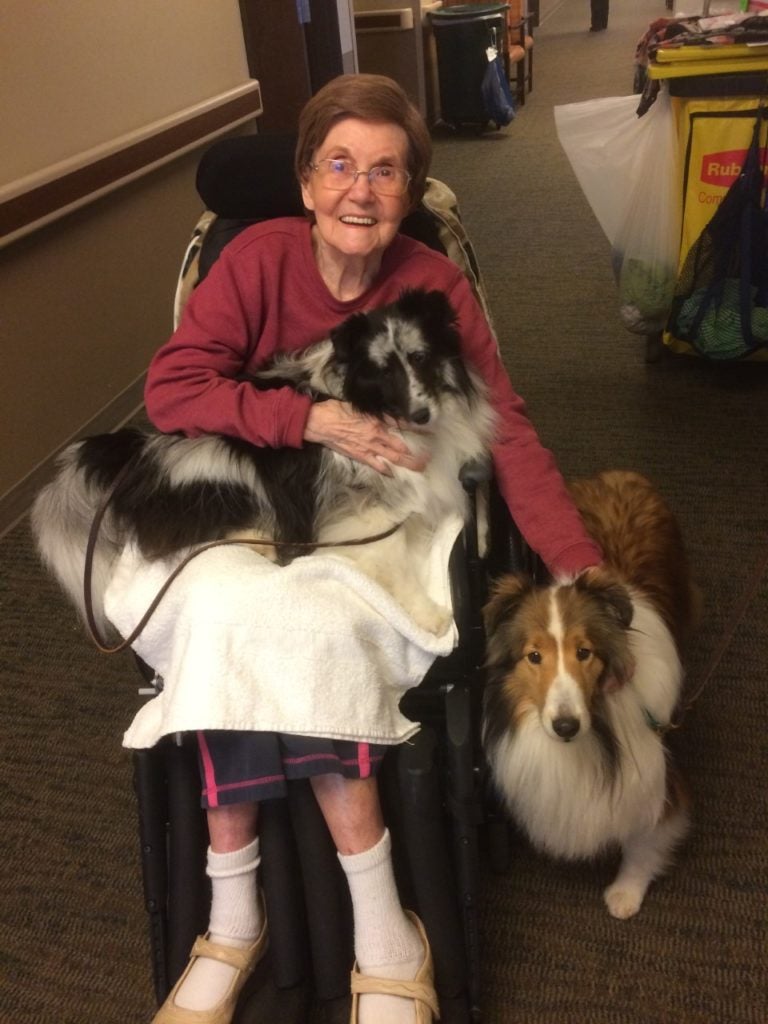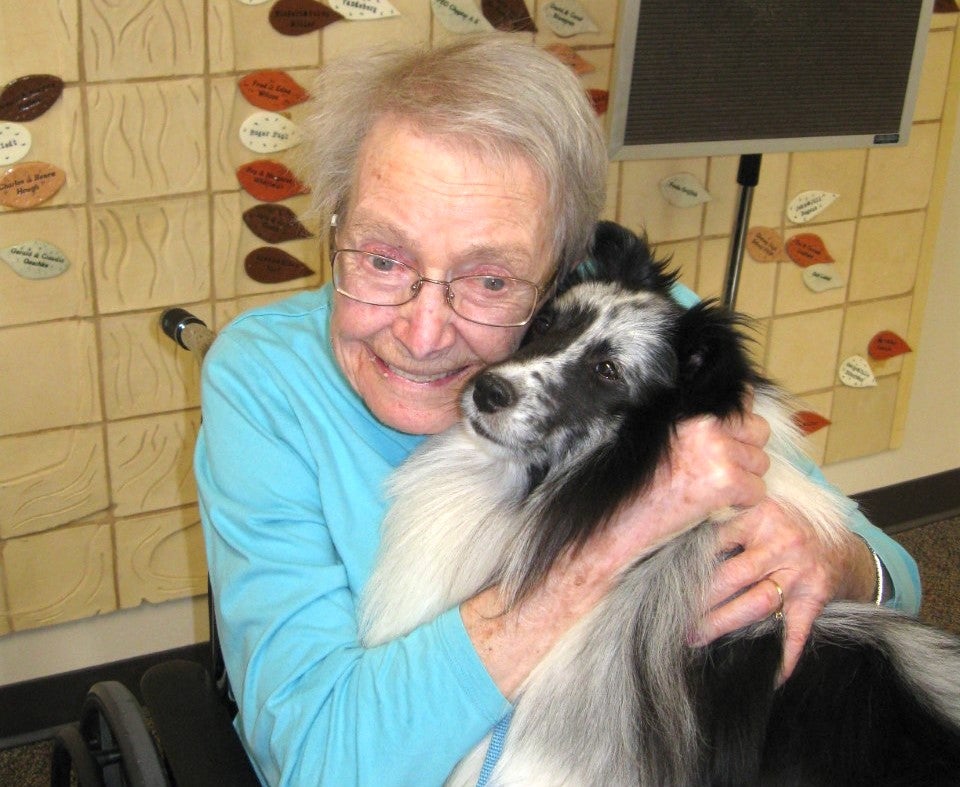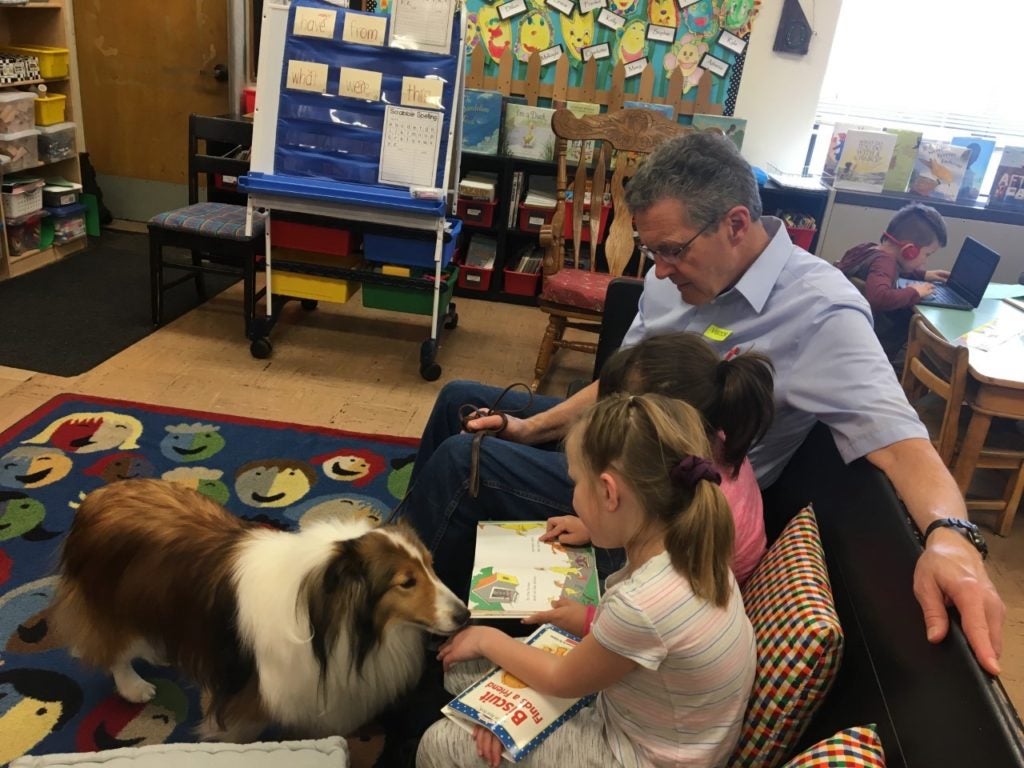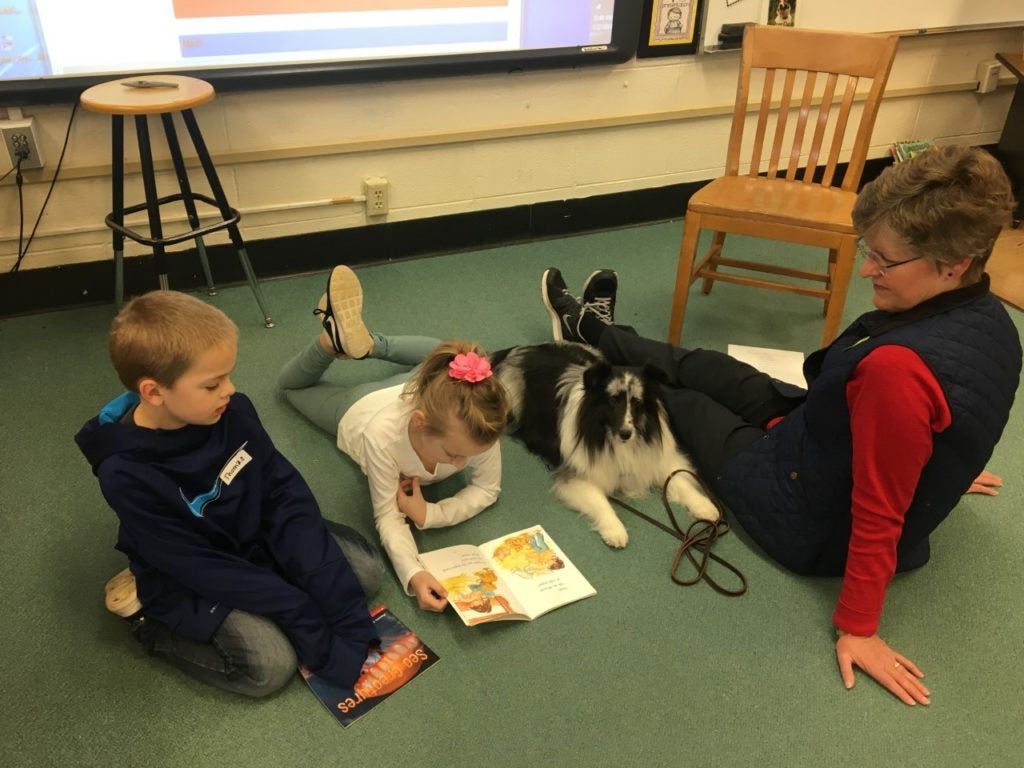
Millions have had midlife career changes. They touch on an amalgam of motivation, health, skills, and behavioral soundness.
Not everyone’s psyche is geared to these life-altering, pressure-point transitions, however. And what about dogs?
A pair of Washington state Shetland Sheepdogs — Brumby and Sonnet — are finding it suits them nicely. Both have discovered how to successfully navigate new pathways as therapy buddies for seniors and college students and as reading advocates for young children.
The Start to a Career
Brumby came to Peggie and Chuck Venemon, of Buckley, Washington, in December 2013 and Sonnet a few months later. Brumby following a show career, and Sonnet, as a pet, from a broken home. Both are now certified therapy dogs through Therapy Dogs International and they love making others happy.
When Brumby’s show career was over, the Venemons purchased him as a pet from his breeder. “I’d always wanted to do therapy work with a dog,” says Peggie Venemon, “but I didn’t have dogs with the right temperament. It turns out Brumby is a born therapy dog and loves nothing more than to cuddle with folks on their bed or in their lap.”
Sonnet’s story, however, is a showcase of tears and emotional angst. The former owner adored and doted on her but one day, unforeseen circumstances forced her to make the difficult decision to return Sonnet to her breeder, Emily Anderson, of Anacortes, Washington. Anderson recalls, “She was sobbing so hard I didn’t think she could make it back to the car after she left Sonnet.”
For about a month, Sonnet’s appetite vanished. Eventually, she began eating normally, but her deep-rooted emptiness lingered. “She would go down to the gate daily and wait for her owner to return,” Anderson laments. “She played with the other dogs for a while but ended up at the gate every time.”
The owner never saw her again but Anderson assured her Sonnet found a good home.

Searching for Sonnet
So how did Sonnet find her way to the Venemons?
“We had been looking for a dog after losing our last two one-and-a-half years earlier,” says Peggie Venemon. “We needed time to recover from their wrenching final illnesses – and Shelties were on our short list. We visited Emily and asked to be on the wait list for a puppy. The next litter had only three and we were fourth on the list. We sighed and began to look elsewhere.
“At that point we heard about Brumby’s availability and he came to live with us. Just as soon as that happened, Emily contacted me to say she had a dog for us. Sonnet had just been relinquished to her three months earlier but she wanted to wait before rehoming her, in case the owner changed her mind. We were torn, as we had decided to only have one dog this time around. But after hearing Sonnet’s story and then meeting her, we opted to bring her home, too.”
Neither has a champion designation in the show ring but each is a winner everywhere they visit. Both have Achiever Dog and Canine Good Citizen titles along with a Therapy Dog designation. The 8-year-old Brumby is closing in on a THDA (Therapy Dog Advanced) title, as well. Both also have Obedience and Rally titles, chiefly attained in Pacific Northwest competitions.
Team Venemon’s primary therapy focus is nursing homes, where each dog differs in temperament and approach. Sonnet, says Venemon, “moves forward with a smile, wagging tail and looks the residents in the eyes. She enjoys having a relationship. Because she is a sable, oversize Sheltie, she often reminds many of Collies they had when they were young. This, of course, makes for a good starter in conversations.
“She is too large to get on peoples’ laps or beds, but occasionally she will surprise us and put her front feet on their bed. We never know when that will happen, but she recognizes who needs it.”

The Beginning of Brumby’s Career
“Brumby, on the other hand, doesn’t usually seem to care about having a relationship with the residents,” Venemon says. “Sometimes he will greet them with eye contact, but more often when I place him on their lap or their bed, he just snuggles up next to the resident and settles in. Often he will lay his head across their chest while they’re lying in bed. Because he is fluffy, he invites lots of petting.
“It’s so rewarding to see the residents’ anxiety and depression melt away as they interact with him” – at the Puyallup (Washington) Nursing and Rehabilitation Center. “We go weekly and try to keep the visits to 1½ hours since the dogs work hard and become tired.”
The couple discovered only by accident that Brumby – before Sonnet joined the family – was born to be a therapy dog. Prior to a weekend drive cross-state to Spokane, they were notified their dog sitter was unable to take Brumby. Suddenly, it became, “Hey, Brumby, how do you feel about a road trip?” En route, they stopped in Cheney (an Eastern Washington town approximately 14 miles southwest of Spokane) to visit Chuck Venemon’s elderly aunt in a nursing home. She adored dogs and wanted to hold Brumby on her lap. He positioned himself comfortably, looking a little precarious but not objecting, recalls Peggie Venemon. “That was an eye-opener for us and the beginning of a new career for both Brumby and us.”

Impacting the Residents of Puyallup Nursing Facility
With unflinching detail, Venemon recalls a few poignant memories of the dogs working their magic with residents at the Puyallup nursing facility.
“Larry was nonverbal and slept slumped over in his wheelchair much of the time. Not knowing if there was a protocol, I decided to wake him up and ask if he would like to hold Brumby. He mumbled something, which I couldn’t understand, so I gently placed Brumby in his lap. Larry immediately smiled and began petting him and playing with the hair around his ears, then he leaned over and served up a kiss on top of his head, totally absorbed in the dog.
“When it was time to move on, Larry looked up at me and his smile disappeared. His whole body seemed to droop. It broke my heart. He died not long after that. I wanted to send a card to his family, but the staff told me he had no family. I am grateful that at least we brought a few minutes of happiness as he neared the end of his life.
“Ernie loves dogs and whenever he sees Brumby and Sonnet, he falls into a reflective mood and relates when he was a teenager and took the family’s pot of stew out of the refrigerator to serve to a starving dog. ‘And you know, I never got in trouble!’ he says. He recites the same story every week and we never tire of hearing it.
“Donna always feels sick and depressed, expecting to die soon. But when Chuck takes Sonnet to see her, she peers in her eyes and smiles, ‘Oh, don’t I just love you!’
“Lawrence is nonverbal following a laryngectomy and breathes through a tracheotomy. He also has severe tremors in his hands. He is alone in his room and never socializes with fellow residents but he loves our visits. Brumby sits on his lap as he reclines in his chair and Sonnet stands alongside him while Lawrence pets him them both the best he can. At the end of our first visit, I told him we’d be back next week. He mouthed with a smile, ‘Promise.’ I promised, and he has become one of our favorites.
“And then there is Frank, who is deaf, mute and in a wheelchair. On Brumby’s second visit to the facility, the two developed a special connection. Brumby looked Frank in the eyes and smiled at him, wagging his tail and lying down beside his wheelchair while Frank petted him. When it was time to leave, Frank looked up, gave a firm nod and a thumbs up. We have been friends ever since.”

Elementary School Inspiration
The emotional acuity served up by these two Shelties extends to a first-grade classroom under the representation of TDI’s Tail Waggin Tutors. Both are newbies in this corridor but Byron Kibler Elementary School (Enumclaw, Washington) first-grade teacher Rita Hyatt, whose class they visit, is thrilled to have them.
A dog owner herself, she instructs the students on how to properly interact with dogs. In the process, she sees the dogs socializing differently with the kids, depending on the individual’s personality and needs, adds Venemon.
This facet of the therapy-dog landscape required plenty of preparatory work by the couple, since neither dog had much contact with children before they came to live with them – Brumby at age 3 and Sonnet at 1½. For years, Peggie Venemon took them on walks every morning past the local school bus-stop and encouraged the youngsters to approach them slowly and gently. Now Sonnet pulls at the leash to greet them, but Brumby continued to hang back until he met one troubled child in Hyatt’s classroom.
Hyatt recalls the synergy: “This child has had many adverse situations in his life and this year he has been homeless. He’s had 42 absences and 30 tardies. He has struggled with anxiety and not wanting to attend school. There is no male figure in his life. He had no guest for our Dudes and Donuts (an event Hyatt hosts in her classroom the Thursday before Father’s Day), but I am working on remedying that. He is generally on the sidelines of the classroom and doesn’t engage. Brumby sensed that right away and settled in right next to him.”
The students, Hyatt says, anticipate each Wednesday visit by Venemon and the dogs. “They keep track of who read first the last time and if one of them missed a turn reading. There are many children in my room who have benefitted from having Brumby and Sonnet spend time with us.”

The Many Benefits of Brumby and Sonnet
The dogs’ landscape extends to Pacific Lutheran University in Tacoma and two nearby community colleges, where they attract plenty of hugs, pets, and verbal interaction with students during midterm and finals weeks. “They’re the perfect stress busters,” adds Chuck Venemon. “The students can’t get enough of Sonnet and Brumby. When we leave the students ask, ‘When will you be back?’ “
Both Peggie and Chuck have retired within the past two years, segueing into volunteer work. “Becoming involved in other people’s lives through our dogs has opened doors of friendships and opportunities we never could have imagined,” she concluded.
How to Become a Therapy Dog
If you think your dog sounds like Brumby or Sonnet, he may be a Therapy Dog in the making. The first step to enrolling in the program is to have your dog trained and certified by a qualified therapy dog organization. Then, record your visits using the guidelines provided. When you’re ready to apply for an AKC Therapy Dog title, just complete the AKC Therapy Dog Title Application and mail to the AKC address shown on the application with a $20 recording fee. If your application is not approved for some reason, we will notify you and refund your fee.
How to Become a Reading Dog
The AKC B.A.R.K. (Be a Reading Kid) Program invites children of all ages to read a book of their choosing to a dog. They may read to their own dog, a dog belonging to a family member or friend, or a dog belonging to an AKC Canine Ambassador that has been approved to participate in the AKC B.A.R.K. Program. Once hours are submitted, the children will receive incentives based on the number of hours they read. You can be approved as AKC Canine Ambassadors using the directions here.

